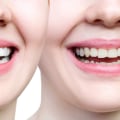As can be seen in the table, the first teeth begin to cross the gums around 6 months of age. Usually, the two lower central incisors (the two lower front teeth) are the first to come out. Then, the four upper front teeth come out. After that, other teeth begin to be filled slowly, usually in pairs, one on each side of the upper or lower jaw, until all 20 teeth (10 in the upper jaw and 10 in the lower jaw) have come out when the child is between 2 and a half and 3 years old. The full set of primary teeth is found in the mouth from 2 ½ to 3 years of age and up to 6 to 7 years of age.
To understand the problems that decayed baby teeth can cause to permanent teeth, it is important to know that primary teeth are significantly more constricted at the dentine-enamel junction (DEJ) than permanent teeth. The tests established to determine the extent of pulp inflammation are inaccurate at best and may be of little or no value in young, anxious children and in permanent, primary or immature teeth. The results of studies on this topic are inconsistent and range from the same incidence of enamel defects in treated and untreated contralateral teeth to an increase in defects and positional alterations of the underlying permanent tooth. The roots of the primary molars are long and thin compared to the length and width of the crown, and diverge to allow for the permanent formation of dental buds. In the case of immature permanent teeth, one should always consider comparing root formation with that of the contralateral tooth.
However, this rule does not apply to young permanent teeth with incomplete root development, where the premature loss of vital pulp functions is so catastrophic that everything possible must be done to safeguard tooth development. Pulpotomy techniques for partial preservation of pulp tissue are also presented as legitimate therapies in primary teeth, where young, well-perfused tissues are combined with the relatively transient nature of dentition to achieve success. In young permanent teeth, therapies strive to keep the apical pulp well perfused and resilient, at least until root formation is complete. The premature loss of primary teeth can cause an aberration of the length of the arch, causing a mesial drift of the permanent teeth and subsequent malocclusion. Primary teeth with a history of spontaneous toothache are not reliable candidates for vital pulp therapy and should not be considered for any type of treatment other than pulpectomy or extraction. Certainly, in the case of immature permanent teeth, the presence of calcifying metamorphosis within the coronal pulp chamber alone would not justify pulpectomy or root canal treatment. What is required in most traditions is to fast and abstain from eating meat, eggs and dairy products on Clean Monday and Good Friday (Good Friday).
The American Academy of Pediatric Dentistry (AAPD) guidelines for pulp therapy for permanent, primary and young teeth describe pulpotomy procedure on primary teeth as amputating the affected or infected coronal portion of dental pulp while preserving vitality and function of all or part of remaining root pulp. These professionals argue that such efforts may pose a risk to development of permanent successors and, in any case, primary teeth will be lost in a short time. A thinner dentin in primary tooth compared to permanent tooth may increase risk of pulp exposure if primary tooth is re-inserted to eliminate residual decay. This is a perfectly natural growth process that provides space needed for larger permanent teeth to emerge. This chapter attempts to provide a review of current therapies for prevention and treatment of pulp disease in primary and young permanent teeth.







